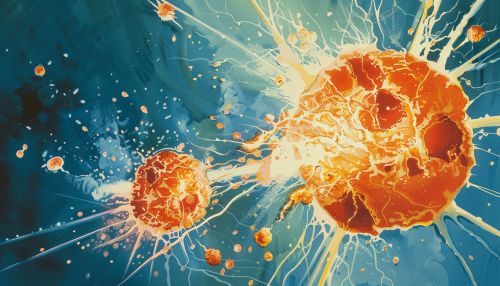Nuclear Chain Reaction
Introduction
A nuclear chain reaction is a series of nuclear reactions where a reactive product or by-product causes additional reactions to take place. This process is fundamental to both nuclear reactors and nuclear weapons. The concept of a chain reaction was first theorized by Hungarian physicist Leó Szilárd in 1933, and it has since become a cornerstone of nuclear physics and engineering.
Basic Principles
A nuclear chain reaction occurs when a nucleus of a suitable isotope undergoes fission, releasing energy and neutrons. These neutrons can then induce fission in other nuclei, perpetuating the cycle. The most commonly used isotopes for fission are uranium-235 and plutonium-239.
Fission Process
In the fission process, a heavy nucleus splits into two lighter nuclei, along with a few neutrons and a significant amount of energy. The energy released in fission is due to the conversion of mass into energy, as described by Einstein's equation, E=mc². The neutrons released can then cause further fission events, leading to a self-sustaining chain reaction.


Types of Chain Reactions
There are two primary types of nuclear chain reactions: controlled and uncontrolled.
Controlled Chain Reactions
Controlled chain reactions are the basis for nuclear power generation. In a nuclear reactor, the reaction rate is regulated using control rods, which absorb excess neutrons. This ensures that the reaction proceeds at a steady rate, producing a consistent amount of energy. The heat generated from the reaction is used to produce steam, which drives turbines to generate electricity.
Uncontrolled Chain Reactions
Uncontrolled chain reactions occur in nuclear weapons. In this case, the reaction rate is not regulated, leading to a rapid, exponential increase in energy release. This results in a massive explosion. The design of nuclear weapons ensures that a critical mass of fissile material is rapidly assembled, initiating an uncontrolled chain reaction.
Critical Mass
The concept of critical mass is crucial to understanding nuclear chain reactions. Critical mass is the minimum amount of fissile material needed to maintain a self-sustaining chain reaction. If the mass of the material is below this threshold, the reaction will fizzle out. If it is above, the reaction can become self-sustaining or even exponential.
Moderators and Reflectors
In nuclear reactors, moderators and reflectors are used to enhance the efficiency of the chain reaction.
Moderators
Moderators are materials that slow down neutrons, increasing the likelihood of fission. Common moderators include water, heavy water, and graphite. Slower neutrons, known as thermal neutrons, are more likely to induce fission in uranium-235 and plutonium-239.
Reflectors
Reflectors are materials that bounce neutrons back into the reactor core, increasing the probability of further fission events. Reflectors help to conserve neutrons and improve the overall efficiency of the reactor.
Safety Mechanisms
Safety is a paramount concern in nuclear reactors. Several mechanisms are in place to ensure the reaction remains controlled.
Control Rods
Control rods are made of materials that absorb neutrons, such as cadmium, boron, or hafnium. By adjusting the position of the control rods within the reactor core, operators can regulate the reaction rate.
Coolant Systems
Coolant systems are used to remove heat from the reactor core and transfer it to the steam generators. Common coolants include water, liquid sodium, and gas. The coolant also serves to prevent the reactor from overheating and potentially melting down.
Containment Structures
Containment structures are designed to prevent the release of radioactive materials in the event of an accident. These structures are typically made of thick concrete and steel and are built to withstand extreme conditions.
Applications
Nuclear chain reactions have a wide range of applications, from energy production to medical treatments.
Energy Production
The most significant application of controlled nuclear chain reactions is in nuclear power plants. These facilities generate a substantial portion of the world's electricity, providing a low-carbon alternative to fossil fuels.
Medical Applications
Nuclear reactions are also used in radiation therapy for cancer treatment. Radioisotopes produced in reactors are used to target and destroy cancer cells.
Research
Nuclear reactors are used in scientific research to study the properties of materials and to produce isotopes for various applications.
Challenges and Controversies
While nuclear chain reactions offer numerous benefits, they also pose significant challenges and controversies.
Nuclear Waste
One of the primary challenges is the disposal of nuclear waste. Spent fuel rods remain radioactive for thousands of years and require secure storage solutions.
Nuclear Proliferation
The potential for nuclear proliferation is another major concern. The technology used for peaceful nuclear energy can also be used to develop nuclear weapons, raising geopolitical and security issues.
Accidents
Nuclear accidents, such as those at Chernobyl and Fukushima, have highlighted the potential risks associated with nuclear power. These incidents have led to increased scrutiny and regulatory oversight.
Future Prospects
The future of nuclear chain reactions lies in advanced reactor designs and fusion technology.
Advanced Reactors
Next-generation reactors, such as small modular reactors (SMRs) and Generation IV reactors, promise to be safer and more efficient. These designs aim to reduce the risk of accidents and improve waste management.
Fusion Technology
Fusion technology, which involves combining light nuclei to form heavier nuclei, offers the potential for nearly limitless energy with minimal waste. While still in the experimental stage, fusion reactors like ITER are making significant progress.
